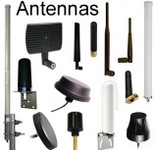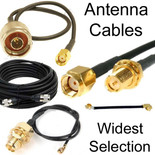Antennas, Antenna Cables, Wireless Products: Technical Articles
RFID Wireless Technologies, Frequencies and Applications in IoT
Table of Contents
Wireless Technologies used in RFID applications

RFID transmits across three main frequency ranges on the electromagnetic spectrum.
- The low frequency band of 120-150kHz is used for basic identification with a range of up to 10 centimeters (four inches).
- High frequency RFID bands operate at 13.5 MHz, an ISM band, with applications in smart cards and memory cards. Transmission ranges are up to 1 meter.
- Ultra high frequency RFID transmission supports short range devices with a frequency of 433MHz and ranges of up to 100m
- Microwave band RFID transmits at frequencies from 865MHz to 10GHz on a variety of ISM bands with ranges of 1 to 200m. At these frequencies RFID operates according to a number of RF standards and protocols such as Bluetooth and 802.11.
About RFID (Radio Frequency identification)
RFID uses radio frequency data transfer for the automatic identification and tracking of RFID-tagged items. This technology has undergone considerable evolution since its development during WWII as a means of identifying aircraft. This wireless auto-ID technology has a wide variety of applications centering on electronically stored information being either transmitted (by active tags) or received (by passive tags). RFID can operate outside of line of sight, or be embedded with tags able to be read within a range of a few inches or centimeters, up to hundreds of meters.
RFID is also classified as an Automatic Identification and Data Capture (AIDC) technology where uniquely identified objects can have data transferred to upstream databases with almost no human intervention.
A simple RFID system will comprise of an RFID tag (also known as a transponder) a reader (also known as a transceiver) and an antenna. Tags typically contain an integrated circuit and antenna in a robust casing, which transmit to the reader. Smart labels contain a printed or etched antenna and minimal circuitry containing the information to be transmitted. The reader communicates with both the tags and an upstream application or data processing system of some kind.
RFID Readers
RFID transceivers can both receive information from the tag and transmit this information onwards to application software. The reader may also be able to communicate bi-directionally, transferring information from the application to the tag. It is usually comprised of a radio frequency interface (RFI) module and control unit.
RFID and IoT
RFID applications have typically focused on asset identification, tracking and control. However next-generation RFID applications are being used in Internet of Things (IoT) deployments, taking advantage of the broad frequency ranges in which RFID operates, particularly the UHF and microwave frequencies.
RFID is able to be utilized as a wireless communication protocol which underpins the identification of objects in IoT. These objects can can be represented in an internet-like structure, monitored and inventoried by computers.
There is currently a convergence of RFID and IoT technologies with developments of internet-based, autonomously operating systems of data capture, transfer and feedback. RFID is now being combined with other information processing equipment such as GPS, GPRS or WSN to network inventoried objects and make them ‘smart’.
As RFID is primarily concerned with the identification of objects, combining this technology with sensors, actuators and upstream internet-based data processing produces an IoT system where items can be monitored and controlled globally in real-time.
Challenges of using RFID in IoT applications
RFID provides great potential for innovative, integrated, IoT based applications, however some limitations and challenges currently exist.
- Interference: RFID communication is simple insecure in its most basic form and susceptible to EM interference and interception.
- Collisions: can also occur between simultaneous transmissions as RFID readers and tags usually operate using the same wireless channels. This causes increased energy and bandwidth consumption and delays in identification.
- Security and Privacy Tags: require effective means of security against eavesdropping or hacking. Without access control mechanisms in place RFID systems can be accessed by unauthorized persons or software and potentially compromise upstream IoT networking.
- Costs: RFID tags are expensive and will require further development and engineering to provide reliable identification and integrate IoT sensor and actuator technologies.
- Integration: RFID requires modification for effective integration into existing IoT systems
Though RFID is an established and widely used wireless technology, it requires more robust access control, authentication and anti-collision protocols as well as refinement to tag designs and reductions in unitary costs to realize its potential.
RFID Antennas
Antennas play a critical role in the operation of RFID systems. They are designed to operate within the designated carrier frequencies of their specific RFID system. They propagate RF energy both vertically and horizontally to create an electromagnetic (EM) field that can be identified along with the transmitted data. The bigger the EM field wave coverage patterns generated by these antennas the lower the overall signal strength.
Passive RFID tags have a flat antenna coil which is activated by supplying an energizing RF signal. Induced antenna coils are typically tag antennas therefore do not require a power source and only communicate their data when energized. The greater the net area of the printed, etched or embedded antenna coil, the further its read range and ability to absorb RF energy.
A wide range of RFID antennas are available and designed to partner with variety of RFID systems. Types include UHF antennas, polarized antennas and patch antennas.
In conclusion
RFID is a versatile wireless technology that operates across multiple frequency bands, enabling applications ranging from simple identification to advanced IoT integration. Its strengths lie in non-line-of-sight communication, scalability, and seamless data capture with minimal human intervention. However, for RFID to fully realize its potential in IoT and beyond, key challenges such as interference, security, cost, and system integration must be addressed. With continued refinement of tag designs, stronger protocols, and integration with complementary technologies, RFID will remain a foundational component in the development of smart, connected systems.
FAQs
What frequency ranges does RFID operate in?
RFID operates across multiple frequency bands, including low frequency (120–150 kHz), high frequency (13.5 MHz), ultra-high frequency (433 MHz), and microwave bands (865 MHz–10 GHz). Each range supports different transmission distances and applications.
What are the main components of an RFID system?
A basic RFID system includes a tag (transponder), a reader (transceiver), and an antenna. The tag stores or transmits data, the reader captures and processes the information, and the antenna enables communication between the two.
How is RFID used in IoT applications?
RFID is increasingly integrated into IoT systems for object identification, tracking, and monitoring. When combined with sensors, actuators, and internet-based data processing, RFID allows for real-time global monitoring and control of connected items.
What challenges does RFID face in IoT deployments?
Challenges include electromagnetic interference, data collisions from simultaneous transmissions, high tag costs, integration issues with existing systems, and security/privacy risks such as eavesdropping and unauthorized access.
What role do RFID antennas play?
Antennas are crucial for propagating RF energy and enabling tag communication. Different designs—such as UHF antennas, polarized antennas, and patch antennas—support varying system requirements. Larger antenna coil areas generally increase read range and efficiency.
What is the difference between passive and active RFID tags?
Passive RFID tags have no power source and rely on energizing signals from readers to transmit data. Active RFID tags, on the other hand, contain their own power source and can transmit data over longer distances.
Why is RFID considered an AIDC (Automatic Identification and Data Capture) technology?
RFID is part of the AIDC family because it enables automatic identification, tracking, and data transfer to upstream systems with minimal human intervention, streamlining processes in supply chains, asset management, and IoT applications.







